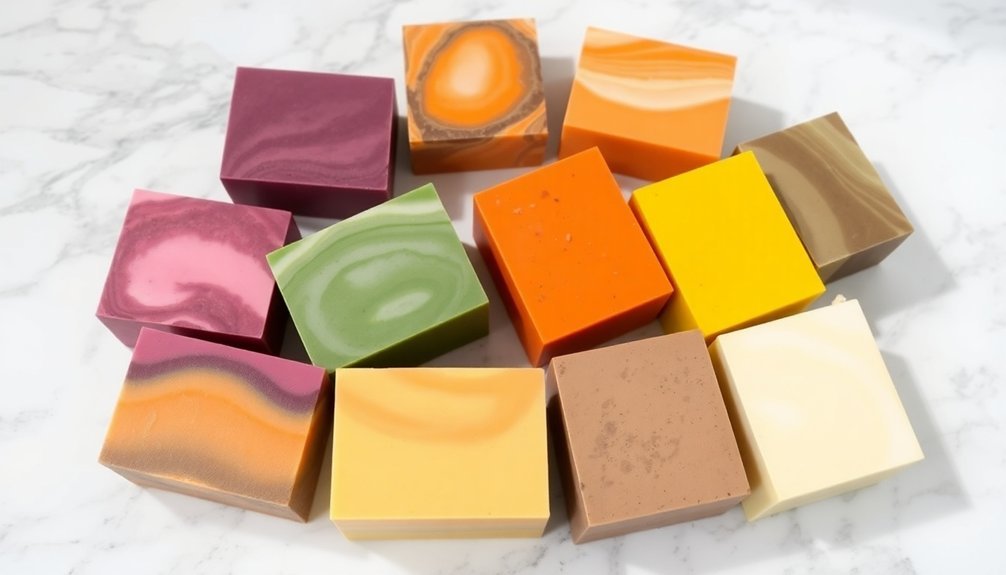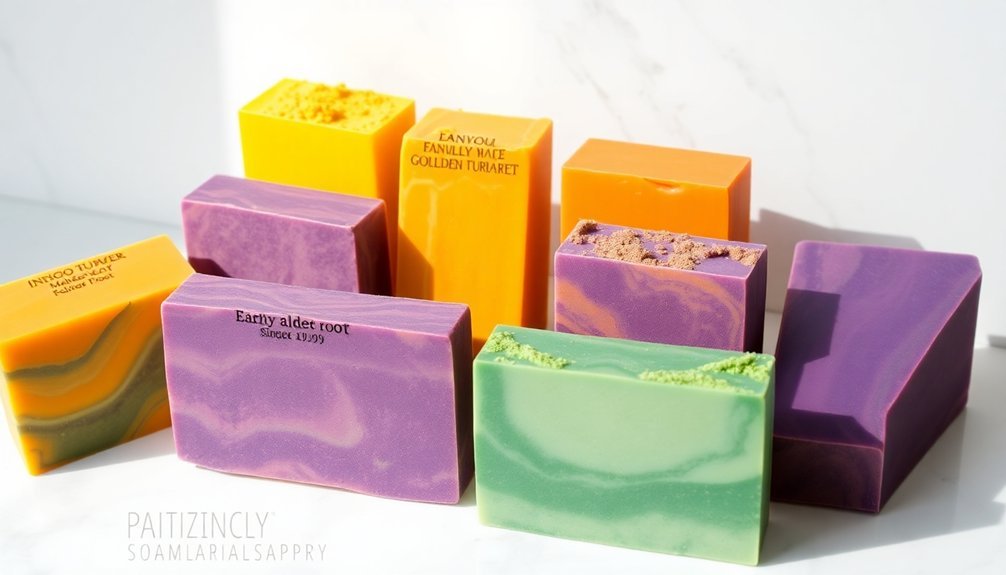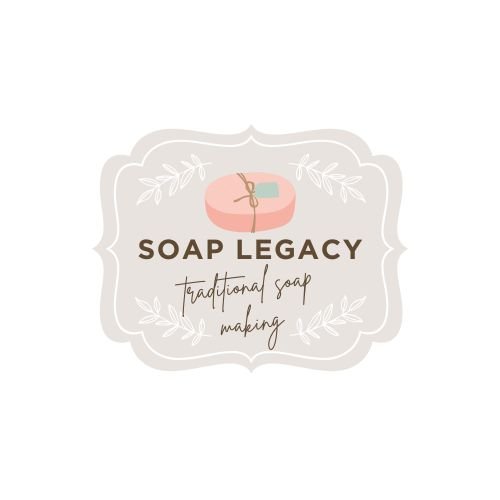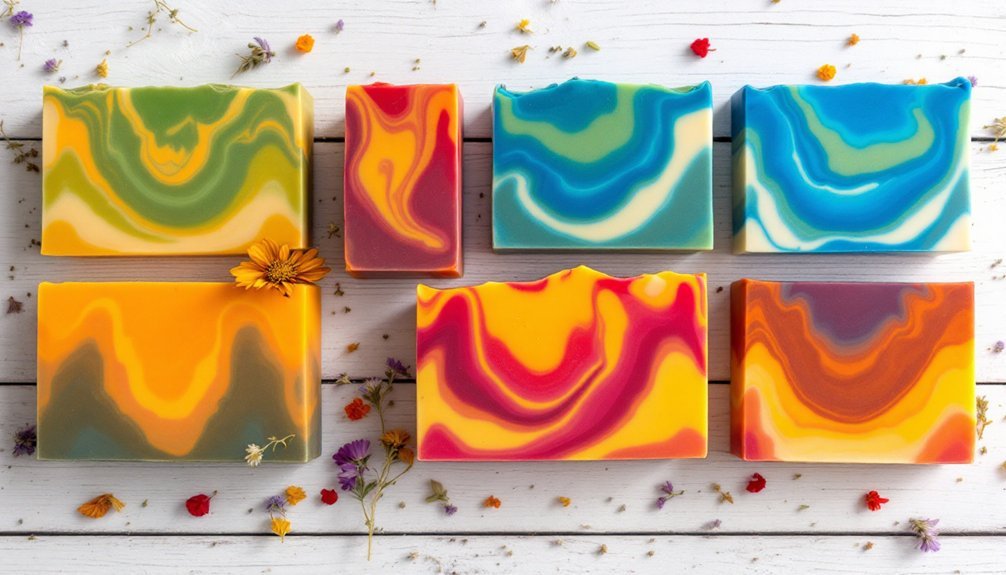You'll find beautiful soap colors using simple plant-based dyes like vibrant yellow turmeric, pink-to-red madder root, purple alkanet root, and bright orange annatto seeds. These natural colorants not only create stunning hues but also add therapeutic benefits to your handmade soaps. For best results, infuse your dyes in light-colored oils like olive pomace, and store them properly away from sunlight. Discover how to blend these botanicals for endless custom shade possibilities.
Essential Plant-Based Dye Sources

Mother Nature provides a stunning palette of plant-based dyes that can transform ordinary soap into vibrant works of art. When you're seeking natural colorants for your beautiful soap creations, several plant materials stand out as exceptional choices.
Turmeric delivers a bold yellow hue while offering anti-inflammatory benefits for skin care. For pink to deep red tones, you'll find Madder root particularly versatile, as it helps soothe skin irritations.
Alkanet root creates stunning purple to red shades during saponification, while Annatto seeds produce bright orange colors while enriching your soap with antioxidants and minerals.
If you're aiming for a subtle touch, cucumber imparts a delicate green shade that's gentle on sensitive skin. These plant-based options not only color your soap naturally but also enhance its therapeutic properties.
Mineral and Clay Colorant Options

You'll find reliable color options in cosmetic-grade mineral pigments like oxides and ultramarines, which offer vibrant hues while maintaining skin safety when used at up to 5% of your total soap weight.
Natural clays, including French pink, French green, and Cambrian blue, provide stable coloring that won't fade over time, making them excellent choices for your soap-making projects.
When selecting mineral and clay colorants, it's crucial to source from reputable suppliers who can verify their products are free from heavy metal contamination.
Clay Types and Properties
Natural clays offer a reliable and multi-beneficial approach to coloring soap, providing both stable hues and enhanced properties. Unlike plant-based colorants that may fade, clay types like French pink, French green, and Cambrian blue deliver consistent, long-lasting colors to your natural soap creations.
When you're selecting clay colorants for your soap, you'll find several advantages:
- Clay provides more stability than many plant-based alternatives.
- You'll get enhanced skin-cleansing properties as clays absorb excess oils.
- The texture of your soap improves with clay additions.
- You can achieve various natural hues without heavy metal concerns.
While mineral pigments offer vibrant options, you'll want to stick with cosmetic-grade varieties to guarantee safety.
Clay's multifunctional nature makes it an excellent choice, delivering both skincare benefits and stable hues in one natural ingredient.
Safe Mineral Color Guide
Selecting safe mineral colorants requires careful consideration of both source and composition. When making natural colorants for your soap, you'll want to focus on cosmetic-grade minerals and clay colorants that are specifically formulated for skin safety.
For the best results, use French pink, French green, and Cambrian blue clays, which offer stable colors without the risks of synthetic dyes. Unlike infused oil from powdered madder or alkanet-infused oil, mineral colorants should never exceed 5% of your total soap weight. This guarantees proper color development while maintaining the soap's quality.
While micas might tempt you with their shine, they often contain synthetic components. Instead, stick to pure mineral colorants and clays that you've verified are free from heavy metal contamination.
This approach assures both safety and natural beauty in your soap making projects.
Preparing Natural Colorant Infusions

You'll begin your natural colorant infusion by combining dried plant materials with olive pomace oil or white base oils in appropriate ratios for each botanical.
While allowing your infusion to steep naturally for several weeks yields ideal results, you can expedite the process using gentle heat from an au Bain Marie method.
Store your finished infusions in airtight, dark glass containers away from direct sunlight to maintain their vibrancy and prevent rancidity.
Oil Infusion Basic Steps
Creating vibrant soap colors from plant dyes begins with proper oil infusion techniques.
You'll need to select dried plant material and a quality carrier oil, like olive oil pomace, to extract color effectively. The process is straightforward, but attention to detail matters for the best results.
Follow these essential steps for successful oil infusion:
- Combine your chosen dried plant material with carrier oil in a glass jar, using a higher ratio of botanicals for more intense colors.
- Let the mixture steep for several weeks, or speed up the process using the au Bain Marie heating method.
- Monitor the infusion regularly to guarantee the plant material remains fully submerged.
- Strain the infused oil through cheesecloth or fine mesh to remove all solid particles before soap making.
The resulting colorant will be ready to create naturally beautiful, evenly-colored soaps.
Safe Storage Methods
Once you've prepared your natural colorant infusions, proper storage becomes essential for maintaining their vibrancy and preventing spoilage. You'll want to keep your soap colorants in airtight glass containers away from direct sunlight and heat to preserve their effectiveness as natural dye sources.
| Storage Factor | Best Practice |
|---|---|
| Container Type | Dark glass jars |
| Location | Cool, dark space |
| Temperature | Room temp or below |
| Duration | Use within 3 months |
| Preparation | Dried plant materials only |
For beautiful soaps, always start with properly dried plant materials when making infusions with liquid oils. If you're working with powdered colorants, mix them with distilled water just before use. Remember to label your storage containers with the date and contents, and regularly check for any signs of rancidity or color degradation to guarantee peak results in your soap making.
Color Intensity and Stability Factors

When working with plant dyes in soap making, several key factors determine both the intensity and longevity of your colors. Your choice of oil used and method of incorporating the plant dye greatly impact your final results.
You'll achieve brighter colors by using white oils like coconut, while darker bases may alter your intended hue.
To maximize your success when coloring soap, consider these essential factors:
- Method of addition – adding dye to the lye solution creates more intense colors than mixing into soap batter
- pH sensitivity – your color stability depends on how the dye reacts during saponification
- Light exposure – natural colors will fade if not properly stored away from direct light
- Base oil selection – lighter oils produce clearer, more vibrant results than darker alternatives
Safe Application Methods and Ratios

To guarantee your soap remains both safe and beautifully colored, proper application methods and precise ratios are essential for working with plant dyes. You'll want to limit plant dyes to 5% of your total soap weight to achieve vibrant colors without compromising quality.
| Method | Best Practice |
|---|---|
| Oil Infusion | Use olive oil (pomace) for stable color infusion |
| Lye Solution | Test small batches before adding colorants |
| Timing | Add during saponification for even distribution |
For the best results, infuse your plant dyes in oil before adding them to your soap batter. You'll find that gelling soap can enhance color brightness, so consider incorporating this step. When mixing colorants, blend thoroughly into the batter rather than sprinkling on top to prevent speckling and guarantee consistent color throughout your finished product.
Blending Techniques for Custom Shades
Beyond mastering basic plant dye applications, creating custom shades opens up endless possibilities for your soap designs.
When making soap with blended dyes, you'll discover how different shades emerge from combining natural plant materials. You can enhance your color results by choosing the right oil base, like coconut oil, which helps showcase your blended dyes beautifully.
To create successful custom shades:
- Start by mixing basic plant dyes like alkanet and annatto to achieve new colors.
- Test small batches to understand how different ratios affect your final shade.
- Document your blending process, noting which combinations work best.
- Record the exact measurements of plant materials used for future batches.
Remember to experiment with various proportions until you find the perfect blend to color your soap exactly as you envision.
Frequently Asked Questions
What Are the Best Natural Dyes for Soap Making?
You'll get stunning results using madder root for reds, annatto seeds for yellows, alkanet root for purples, indigo for blues, and marigold flowers for greenish-yellow tones in your natural soap-making projects.
How to Get Vibrant Colors in Soap?
You'll get vibrant soap colors by using plant-based dyes like madder root, turmeric, and annatto seeds at 5% max concentration. Infuse them in oils first and store finished soaps away from direct light.
How to Make Natural Colors for Soap?
You'll get natural soap colors by infusing oils with plants like madder root for pink, turmeric for yellow, and alkanet for purple. Keep your colorants under 5% of total soap weight for best results.
What Herbs Are Good for Coloring Soap?
You'll get beautiful colors using madder root for pink-red, turmeric for yellow, alkanet root for purple, annatto seeds for orange, and chamomile or calendula for soft yellows in your handmade soaps.
In Summary
You've now got the knowledge to create stunning natural soap colors using simple plant materials, clays, and minerals. Start with small test batches to perfect your ratios and blending techniques. Remember to document your successful combinations and always follow safe handling guidelines. Whether you're using alkanet root, spirulina, or rose clay, you'll find endless possibilities for crafting uniquely colored, all-natural soaps.





Leave a Reply